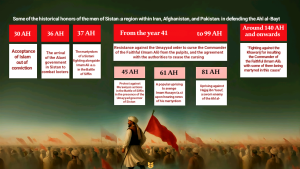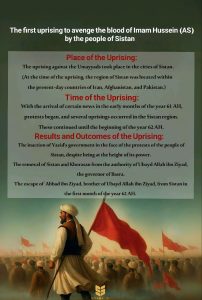Reasons to prove the uprising of the people of Sistan in protest of the event of Karbala
.

“Popular uprisings to avenge the blood of Imam Hussein (peace be upon him)”
.

In the history book of Sistan, it is stated that when the news of the martyrdom of Imam Hussein (AS) and his companions by the Umayyad came to Sistan, the people of Sistan said: “Yazid did not take a good path by killing the descendants of the Prophet (peace be upon them). Some of them started a rebellion. Abbad handed over Sistan to the people of Sistan, twenty times ten thousand dirhams had been collected in the treasury from the spoils of Kabul and other possessions, and Basra. Abdullah bin Ziyad sent his brother Yazid bin Ziyad and his other brother Bu Ubaidah Ziyad to Sistan in the first year of sixty-two”( Sistan’s History, page 100).
The authenticity of a historical event can be proven in various ways: first, whether the book mentioned is reputable or not; second, whether the information provided is also mentioned in other historical sources; and third, whether historical evidence confirms it or not.
The credibility of the Sistan history book
The beginning of this book belongs to the fifth century AH and historians usually consider this book as a credible one because the author, historian of Sistan, used valuable sources that are not easily accessible today. It can be described as one of the three ancient Persian prose books: the history of Bal’ami, the history of Bayhaqi, and the history of Gardizi, which are currently famous. Perhaps, we can say that there are combinations, vocabularies, and terminologies in this book that make it appear older than Bayhaqi and Gardizi.
Mohammad Taghi Malik al-Shoara Bahar introduction to the book “History of Sistan” p.9
This book is a valuable book about the events of Iran in the first Islamic century.
Understanding and criticizing the sources and origins of the history of Iran after Islam p.13
The author’s information on some political, religious, and social events in Sistan is very valuable.
Article A Look at the History of Sistan p.14
A local historical evidence supports this
The background twenty years before the Karbala incident reported among the people of Sistan can be a great source for understanding what happened with the uprising of the people of Sistan after the Karbala incident. When a person explores the historical actions of a region, they might not see the necessary background initially, but based on the points mentioned, it can be said that this background existed in that area. Therefore, accepting the Sistan historical report in connection with the protest actions of the people of Sistan to the martyrdom of Imam Hussein and his companions can be valid for us. Even though this account is unique, we do not rely solely on historical accounts based on narration, sources, and documents, but we also look into confirmations and evidence, some of which are mentioned.
1- The people of Sistan were with Amir al-Mu’minin in the Battle of Siffin in the year 37 Hijri and were martyred in that battle. In the description of Abud Awud Sajistani, it is quoted that Emran from his ancestors was martyred in the Battle of Siffin in the ranks of Amir al-Mu’minin. (History of Damascus vol. 22/191.)
2- The threat of the Umayyad ruler to Sistan and the defense of Amir al-Mu’minin.
The history of Sistan in this regard writes: “When Abd al-Rahman ibn Samra wanted to settle in Sistan, the people of Sistan gathered, the scholars, nobles, and leaders of Sistan said: We must have an imam who is truly righteous, just as the tradition of Mustafa (peace be upon him) remains and now Ali ibn Abi Talib is in place, and Muawiya has sent you here and eighty thousand men from the people of truth have been killed among them. This sermon and prayer must be righteous. We will not be content with this situation…” History of Sistan, p. 89.
Resistance against the decree of the Umayyad dynasty to not curse Amir al-Mu’minin and to curse Imam Ali (peace be upon him) from 41 AH to 99 AH was one of the main objectives of the Umayyad caliphate. Ya’qut Hamawi (d. 626 AH) writes: “More significant than all the qualities mentioned [for the people of Sistan] is that Ali, the Commander of the Faithful (peace be upon him), was cursed in the pulpits of the East and West, but in Sistan, this only happened once, and the people of Sistan defied the Umayyad order. They even included in their pact that no one should curse from their pulpit, what greater honor is there than for them to defy the inappropriate order of cursing the brother of the Messenger of God (peace and blessings be upon him) from their pulpit, while that noble figure was being cursed from the pulpits of Mecca and Medina.”
The text discusses the historical events of Sistan related to a rebellion with other historical sources. It mentions the rule of Abad bin Ziyad over Sistan in the year 61 AH. There is an alignment in the accounts provided in the history of Sistan with other historical sources. It also talks about the insecurity in Sistan and movements against the rule after the martyrdom of Imam Hussein in the region.
The relationship between changes in governance in Sistan and Khorasan and the consequent change in the ruler of Sistan with the event of Karbala | Complete in History, Vol. 4, p. 96
The exit of the slaves from Sistan after the martyrdom of Imam Hussein (AS) (Tabari History, Vol. 5, p. 471, Complete in History, Vol. 4, p. 96)
Being rulerless in Sistan for a period of time (Tabari History, Vol. 5, p. 472, Complete in History, Vol. 4, p. 96, Translation of Ibn Khaldun’s History, Vol. 2, p. 217)
Collecting war spoils and their exit from Sistan (Tabari History, Vol. 5, p. 471, Complete in History, Vol. 4, p. 96, The End of the Prophets in the Arts of Literature, p. 20 and 483…)
The association of Abu Ubaydah with Yazid ibn Ziyad in Sistan (Complete in History, Vol. 4, p. 97, Al-Ma’arif, p. 348)
The exit of the slaves from Sistan and the presence of Yazid ibn Ziyad in the early days of year 62 (Based on the books of the History of Damascus, Vol. 26, p. 234. History of Khalifa ibn Khayyat, p. 219 with the book of Al-Ma’arif of Ibn Qutaybah, p. 348.)
The only thing that seems to distinguish the account presented in the history of Sistan from other sources is that the history of Sistan mentions the sending of Yazid bin Ziyad by Ubaidullah, but as mentioned, Yazid bin Muawiyah deprived Ubaidullah of the governance of Sistan and Khorasan and entrusted it to Salam bin Ziyad. Therefore, Ubaidullah no longer had any authority over the governance of Sistan.
Salam bin Ziyad was appointed Yazid bin Ziyad to the governance of Sistan (Ansaab al-Ashraaf, vol. 5, p. 373, History of Tabari, vol. 5, pp. 471-473).
The absence of opposition to the rejection of this incident
In none of the historical books, any evidence has been found to refute this except for one account.





